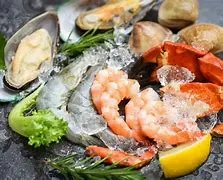Why you should eat more fish (and shellfish) – and the healthiest types to try
From fish and chips by the seaside to baked fillets served with seasonal veg enjoyed al fresco, the weather’s warming up – and we’re entering fish supper season.
While the battered option is the one of the most calorific meals that we all know and love, scrape off the batter and ditch the chips and you’re left with one of the most nutritious foods around. “Fish is very healthy as it is high in protein and typically quite low in fats,” says Anna Daniels, a registered dietitian and spokesperson for the British Dietetic Association.
Throw in the fact that it’s full of vitamins and minerals that contribute to a healthy heart and brain, and it’s essentially a superfood. Research suggests that consuming fish can even make us nicer people – with children who eat enough of it being kinder than their peers.
While four species of fish: cod, haddock, salmon, tuna – and prawns (a shellfish crustacean) – make up 80 per cent of the fish we eat in the UK, other varieties can be healthier. Here, the experts have weighed in on the best types to eat.
The health benefits of white fish
White fish is low in fat and a good source of lean protein, notes Dr Bardon, which makes it helpful when it comes to weight management.
A 100g portion of cod contains around 100 calories, a whopping 20g of protein and no saturated fat. For comparison, the same sized portion of steak contains twice as many calories, for the same amount of protein and nearly 6g of saturated fat.
White fish also provides lots of vitamins, including B vitamins which our bodies need for energy production, nerve function and cell growth. In particular, white fish is a source of vitamins B6 and B12 (which between 3 and 20 per cent of people are deficient in), notes Thornton-Wood.
It dishes up an array of minerals, including selenium, she says. We only need small amounts of this trace mineral, but it’s mighty, forming part of proteins and enzymes that help to make DNA and protect against cell damage. It’s also a source of zinc, which helps the immune system function normally and supports wound healing, and iodine, which is needed to make our thyroid hormones.
Some white fish – such as sea bass, sea bream, turbot and halibut – can be a source of omega-3 fatty acids but at lower levels than oily fish, Thornton-Wood notes.
While all types of white fish are excellent for our health, if you want to maximise the health benefits, Thornton-Wood recommends tucking into pollock. It’s one of the lowest calorie (103), fat (0.6g) and salt (0.16g) options available.
“Pollock is in the Marine Stewardship Council, or MSC, sustainable fish list but similar in flavour and texture to cod,” she says. “It’s also a good source of low fat protein and B12.”
Additionally, it’s worth bearing in mind that smoked options, while tasty, contain much more salt (around 1g per 100g – 10 times more than non-smoked options). We’re told to limit our salt intake to no more than 6g per day, as it can drive up blood pressure, raising the risk of heart attacks and strokes.
What is the healthiest way to eat white fish?
Daniels recommends steaming, grilling or pan-frying fish with a little olive oil, though the latter will increase the calorie and fat content.
Thornton-Wood suggests cooking white fish in a simple tomato-based sauce, as tomatoes release an antioxidant called lycopene when cooked, which benefits eye health, skin health and has even been linked to a lower risk of prostate cancer.
“Add a jacket potato for additional fibre and one serving of another vegetable, such as spinach or peas,” she suggests. The result will be a healthy, balanced meal that provides at least three of your five a day.
How many times a week should you be eating white fish?
Nutritional guidelines in the UK recommend that we eat two portions of fish a week, one of which should be oily, Dr Bardon notes.
But, for most, there’s no harm in having fish more often. “Fish can be eaten daily unless you are pregnant or breastfeeding and you need to be more cautious,” says Daniels.
However, sea bream, sea bass, turbot, halibut and rock salmon shouldn’t be eaten every day because they may contain similar levels of pollutants as oily fish.
Additionally, children, pregnant women and women trying to get pregnant shouldn’t eat shark, swordfish or marlin because they can be high in mercury. Other adults shouldn’t have more than one portion of these fish per week.




0 Response to "Why you should eat more fish (and shellfish) – and the healthiest types to try"
Post a Comment